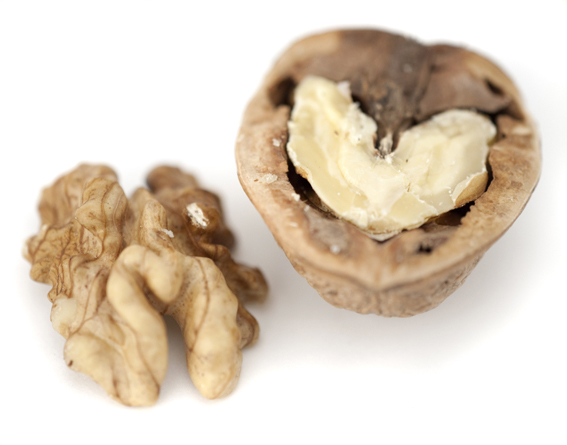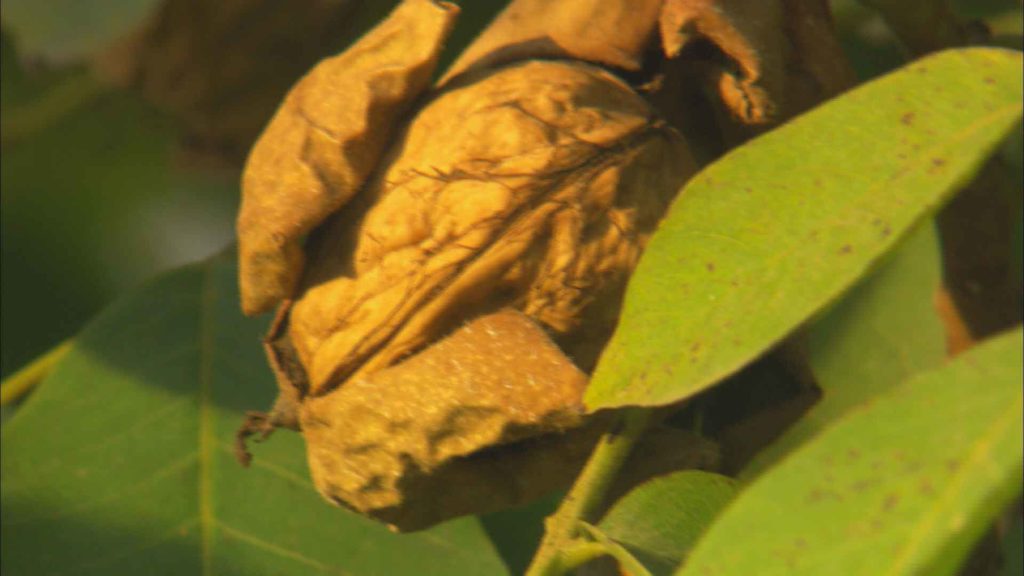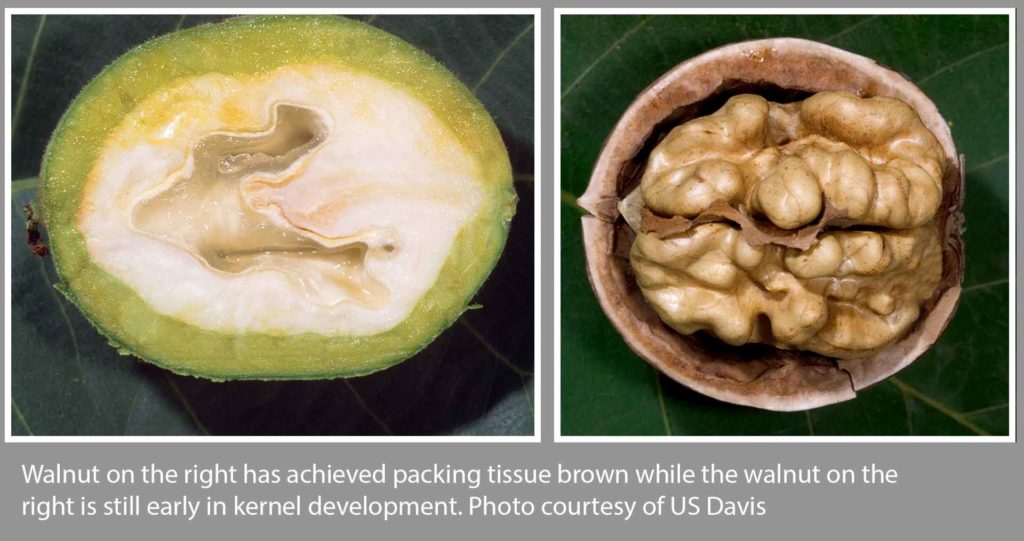Two objectives in using the plant growth regulator Ethephon in walnut production are an earlier harvest and a more efficient harvest.
Ethephon, sold as Ethrel, is converted to ethylene a gas that is responsible for changes in texture, softening, color and other maturation processes. The systemic properties of Ethephon allow it to penetrate plant tissues and decomposed to ethylene. In walnuts, ethylene accelerates walnut hull cracking and separation from the shell, advancing harvest by a week to ten days, depending on season and variety. Harvest efficiency is improved as more uniform maturity is achieved and only a single shake is necessary.
Visalia-based crop consultant Steve Sibbett said the early harvest can ensure more kernels will have the desired light color and help minimize navel orangeworm damage (NOW).
“There is a financial incentive with the lighter colored kernels, less insect infestation and control of harvest,” Sibbett said.
Early Maturing Varieties
Early maturing walnut varieties including Serr, Vina, Tulare and Ivanhoe can benefit from ethephon applications as long as the huller/dryer facility is ready to accommodate the earlier delivery. Mid season varieties such as Tulare also benefit from better quality and a once over harvest. The later maturing Chandler variety holds kernel quality longer and there is really no quality incentive for an early harvest with that variety, Sibbett said. Growers can use ethephon in Chandler blocks to spread out harvest timing and drying.
Research done by University of California (UC) Davis plant sciences department found lower ethylene production in the Serr variety than with Payne, Tulare or Chandler. The Tulare variety, especially in southern growing areas, has the best ethylene response.
Growers and farm managers planning to use ethephon need to be aware that proper application methods and timing are necessary to reap the benefits of this product.
Sibbett explained that walnut kernels are physiologically mature two to three weeks ahead of dropping from the tree. During this time the green hull tissue surrounding the nut cracks and separates. Inside the shell, the kernel also matures and the pellicle, skin around the kernel of most varieties darkens. Risk of navel orangeworm damage increases with harvest delays.
PTB
During the maturation process, the packing tissue surrounding the walnut kernel undergoes a color change. When the packing tissue changes in color from white to a even medium brown color throughout, (termed “packing tissue brown” (PTB)), that is the signal that the ethephon application can be made and achieve the desired results. Ethephon should not be applied earlier as yield loss will occur.
University of California farm advisors stress that monitoring the orchard once or twice weekly for packing tissue color change, planning ethephon applications at night or early morning to avoid temperatures approaching 90 degrees F and coordinating with their harvest crew and huller is important to reap the economic benefits of ethephon. Crop load, weather and variety susceptibility to darkening should also be considered.
Research has shown that packing tissue color changes occur last in the bottom third of the tree canopy and that fully shaded walnut tree canopies have greater maturity variability than those with full sunlight. Sampling should begin at least two weeks before the color change is expected to occur with early varieties. Serr can develop PTB by mid August, a full month ahead of Chandler. Deficit irrigated or stressed trees will develop PTB earlier in the season than well-watered orchards.
Monitoring for PTB
Monitoring for PTB can be done by collecting 100 nuts during a diagonal walk through the orchard, then splitting them open to determine packing tissue color. Nuts must have complete browning of the packing tissue before an application. Ethephon applied before all have PTB can result in losses of kernel weight, quality and difficult hull removal. Application delayed a week past complete PTB is achieved can help with nut removal and may only require a single shake.
The benefits of ethephon are seen as early as seven days to as many as 23 days after application. Hot, dry weather conditions delay ethephon’s effect. A test shake should be done to evaluate hull adhesion before scheduling complete harvest.
Application Methods for Ethephon
Application methods for ethephon can vary depending on growing region. Aerial application and ethephon concentrations greater than those recommended for ground application are allowed and used in Northern California. Aerial applications have not been as effective in southern California possible due to warmer temperatures and drier conditions. Consulting with the agricultural commissioner’s office in the county where the application is planned is advised.
Ethephon is a contact material and must hit the nuts to obtain the desired response. Higher humidity and cool temperatures at application will elicit a better response by the nuts than applications done in windy, hot conditions. Ethephon should not be applied when temperatures exceed 90 degrees F.
Recommended application rates for ground rigs is 4-5 pints of product added to 150-200 gallons per acre, applied at ground speeds of 1.5 to 2 mph, depending on canopy size. Aerial rates are 2-4 pints at 40 gallons per acre, allowed by some labels. Again, the local agricultural commissioner’s office should be consulted for clarification of the legality of aerial applications.
Application rates higher than those on the label can cause defoliation, reduced catkin formation and twig dieback.
Other Considerations
Other considerations for effective ethephon applications are controlling spray drift and carrier water alkalinity. Ethephon breaks down into ethylene quicker as pH of carrier water increases. The goal is to keep the spray solution within the recommended range of 4-5. Ethephon is normally acidic and as the concentration increases the solution pH will decrease.
To avoid drift and ensure more of the product hits the nuts, the largest droplets that provide good coverage and control are desired. The larger droplets will reduce drift potential in good spray conditions, but cannot overcome wind and high temperatures. Solid stream nozzles oriented straight back produce the largest droplets and the lowest drift.

Cecilia Parsons
Cecilia Parsons has lived in the Central Valley community of Ducor since 1976, covering agriculture for numerous agricultural publications over the years. She has found and nurtured many wonderful and helpful contacts in the ag community, including the UCCE advisors, allowing for news coverage that focuses on the basics of food production.
She is always on the search for new ag topics that can help growers and processors in the San Joaquin Valley improve their bottom line.
In her free time, Cecilia rides her horse, Holly in ranch versatility shows and raises registered Shetland sheep which she exhibits at county and state fairs during the summer.


















